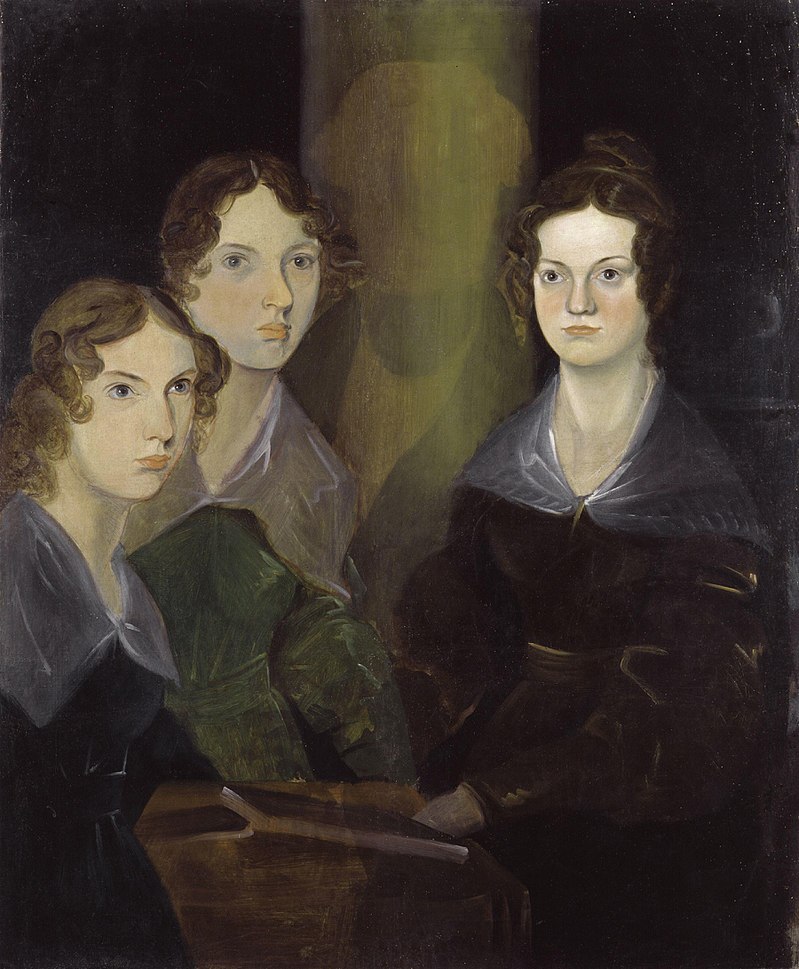(This “ranking” is obviously just my opinion!)
I guess I first heard about the Brontës when I was in high school and then studied them properly at university (I studied English). However, I only started reading them properly after university. In this blog post, I don’t talk about the novels in detail, but I do explain why I love/don’t love them and list some interesting facts about the authors’ lives.
Emily Brontë
Emily only wrote one novel: Wuthering Heights. She was the second youngest of the surviving Brontë siblings; her younger sister Anne was also her best friend. Together, they created the fictional world of Gondal, wrote poetry and read it aloud to each other.
Emily is thought to have lived a secluded life and made few friends throughout her (short) life. She was close to her family and very attached to her home in Yorkshire. She was shy and quiet, and kept to herself, even though she was interested in other people’s life stories. Emily Brontë died when she was 30 from tuberculosis. Who knows what other amazing stories she would’ve written had she lived longer.
As far as we know, Emily never formed a romantic relationship with anyone. Yet, she wrote one of the most passionate novels of all time. People keep stealing love quotes from it (ahem Anna Todd), many not realising that they don’t want the relationship that Cathy and Heathcliff had (and didn’t have).

Wuthering Heights
Wuthering Heights is a gothic novel, influenced by romanticism. It’s a combination of two speakers; they outline the events of the plot in a framework of a story within a story. Many critics were appalled by the savageness and selfishness depicted in the novel. They questioned the morality of the story because of how passionate it was. They, however, had to admit that it was both powerful and imaginative. Throughout the years, critics began to recognize that Wuthering Heights is at least as great a literary work as Charlotte’s Jane Eyre (if not better).
Many people see Wuthering Heights as a love story, while some argue that it isn’t about love at all. I personally think that it is about love, but also about class and money, childhood, morality, religion and race. There is as much selfishness and revenge between Cathy and Heathcliff as there is love. And then there are many questions that Emily left unanswered and are still being debated today: Were they half-siblings? Was their relationship really sexless? Not to mention the feminist theme in the novel.
Charlotte Brontë
Charlotte was the oldest of the three sisters, the one who lived the longest (38) and the only one who got married. After her mother’s death, she, with the help of her aunt, became a motherly figure for her younger siblings. The children created the magical worlds of Angria and Gondal, and the sisters published poetry together. Charlotte worked as a governess and spent some time studying and teaching in Brussels with Emily.
She was of a petite frame but of a determined character. She saw herself as a poet and a writer despite the general view that these weren’t appropriate professions for a woman. The three sisters published under the names Currer, Ellis and Acton Bell to avoid any possible problems. After the death of her sisters, Charlotte had some control over the publication of their works; she is believed to have rewritten some parts (especially in Emily’s poems) and suppressed the republication of Anne’s second novel, The Tenant of Wildfell Hall. Also, Charlotte is believed to be an unreliable source of information about Emily; she might have exaggerated the shyness of her sister.
While living in Brussels, Charlotte developed feelings for a married man, Constantin Héger. She had written many letters to him, but he only responded to some. Charlotte got married to Arthur Bell Nicholls, her father’s curate, when she was 36, got pregnant soon after her marriage, but died just before her 39th birthday with her unborn child. She died from dehydration and malnourishment due to vomiting caused by severe morning sickness.

Jane Eyre
Jane Eyre is the first novel that Charlotte managed to get published, even though she had written one before (The Professor). It’s the most famous of all her works and in my opinion the most likeable one. It combines romanticism, naturalism and gothic melodrama. Just like Wuthering Heights, it was very innovative at the time. The crazy wife, the fire, the brave girl, the scary house and, of course, the love story. Jane Eyre is a story that’s compelling from the beginning till the very end.
Jane Eyre is essentially a bildungsroman. It starts with Jane’s miserable childhood, then takes us to Thornfield Hall, where we are witnesses to her falling in love with Mr Rochester. The fact that it’s written in the first person makes it a lot more personal. It feels like Jane is inviting us to join her and hear about her life story.
The Professor
The Professor was Charlotte’s first novel, but it was published posthumously, in 1857. “The Professor” is William Crimsworth, a young man who starts working as a clerk for his rich brother. Because the latter treats him horribly, he takes an acquaintance’s advice and travels to Brussels to teach English. The rest of the story is about how he nearly falls in love, is deceived, and then falls in love with someone else. Just like with Jane, we witness how he grows up, finds a profession he enjoys, a person who loves him and settles down.
The Professor is another bildungsroman, also told in the first person. However, it lacks the passion, mystery, and gothic vibe of Jane Eyre. It isn’t half as exciting. It was difficult for me to identify myself with William, while it was very easy to do so with Jane. Maybe because he’s a man? Who knows.
Villette
Villette is Charlotte’s third novel, set in the fictional Belgian gothic town of Villette. This novel is written in the first person too and is also a bildungsroman. It follows the life of Lucy Snowe, who is a somewhat passive and observant character. Just like Jane, she’s described as plain. Contrary to Jane Eyre, this novel explores Lucy’s psychology (isolation and displacement especially), gender roles and repression. Jane is the one who seems braver, more decisive, and the one who knows what she wants, but Lucy is the one who truly breaks free of the expected domestic fate in the end.
At times, Lucy can be sarcastic and funny (especially when she talks to Ginevra). Sometimes, though, when she’s thinking and observing, the prose is basically stream-of-consciousness. This explains the novel’s length (993 pages). I sometimes wished the story would unfold faster, the events happen more quickly. I did enjoy the book, especially because it contains real experiences from the time Charlotte spent in Brussels; there’s probably a lot of Constantin Héger in M. Paul Emanuel. In my opinion, though, Villette is not nearly as gripping as Jane Eyre.
Shirley
To be completely honest with you, I haven’t finished this book. I started listening to the audio version, but I had a little break to listen to Villette instead. What I’ve heard so far hasn’t really convinced me; I found it boring, and it was hard for me to concentrate on it. This might be because Shirley, Charlotte’s second published novel, is narrated by an omniscient but unnamed third-person narrator, which makes it more impersonal. I’m quite sure that it’ll be my least favourite of all Charlotte’s novels. It’s about a mill owner, Robert Moore, his cousin Caroline and the heiress Shirley. There’s also a guy called Louise. I think that the omniscient narrator and the larger-than-usual number of main characters are what makes this book less fascinating.
Anne Brontë
Anne was the youngest of the Brontë literary family. Just like her sisters, she spent most of her life at the parish of Haworth on the Yorkshire moors. She also attended a boarding school and worked as a governess. Like Charlotte and Emily, she was a writer and a poet.
Anne and Emily were very close; when Anne was 11, she and Emily broke away from Charlotte and Branwell’s world of Angria to create and develop their own fantasy world, Gondal. Charlotte’s friend Ellen Nussey described the girls as “twins”.
Anne died at 29, probably of tuberculosis. After her death, Charlotte edited Agnes Grey to fix issues with its first edition and prevented the republication of The Tenant of Wildfell Hall. This is one of the reasons why Anne is not as well known as her sisters. Nonetheless, both of her novels are considered to be classics of English literature.

Agnes Grey
Agnes Grey was published together with Wuthering Heights in December 1847 but was outshone by Emily’s more dramatic novel. It’s largely based on Anne’s own experience as a governess. Agnes is a young woman who decided to become a governess to help her family out financially. She has a hard time working as a governess due to her unreasonable employers and their spoilt children (which was Anne’s experience too). Agnes Grey is a love story: the main protagonist falls in love with a curate, Mr Edward Weston. It’s somewhat of a bildungsroman too.
Agnes Grey is written in a simple prose style, which is witty and easy to read. It’s a “nice story” in all aspects, but it isn’t striking like Wuthering Heights or Jane Eyre.
The Tenant of Wildfell Hall
The Tenant of Wildfell Hall is the second and final novel of Anne Brontë. At the time of its publication (1848), it was considered shocking, which is probably why it had instant and phenomenal success. The novel consists of a series of letters from Gilbert Markham to his friend about his meeting a mysterious young widow, Helen Graham. The story is told from Gilbert’s point of view, except when Helen gives him her diary. This is when we get to hear her story, also told in the first person.
Helen is the exact opposite of what a woman was expected to be at that time: she lives alone with her son and makes an income by selling her own paintings. When Helen left her husband and took away their child, she violated not only social conventions but also early 19th-century English law. The Tenant of Wildfell Hall is now considered to be one of the first feminist novels.
I absolutely loved The Tenant of Wildfell Hall. The themes in it are extremely innovative for that time: alcoholism, domestic violence, adultery and female artists weren’t easily found in works of the early 19th century. In both novels, Anne opted for realism and not romanticism (which prevails in her sisters’ novels). Wildfell Hall isn’t a haunted house like Wuthering Heights or Thornfield Hall, it’s just old, damp and unwelcoming. Arthur Huntington is not intelligent or strong like Heathcliff or fundamentally good like Rochester, he’s just a violent drunk.
Ranking of the novels:
- Wuthering Heights
- Jane Eyre
- The Tenant of Wildfell Hall
- Villette
- Agnes Grey
- The Professor
- Shirley

- Just to be clear, I think that all Brontë sisters were extremely talented. I haven’t read their poems yet, but their prose is fantastic. Charlotte might have written more novels (she had more time, to be fair), but I find Emily to be the best writer. I’ve read Wuthering Heights twice, and I’m sure I’ll read it many more times. Heathcliff and Cathy as characters are both so fascinating, Nelly’s narrative so wholesome, Mr Lockwood’s irony on point, the setting so attractively gothic and, of course, Cathy’s and Heathcliff’s quotes, the declarations of love, often masked as passionate arguments, are absolutely wonderful. I also love all the shady parts of the plot, such as the possibility of them being related, all the unanswered questions, all the frustration and the could-have-beens. I’ve never loved any book more.
- To me, Jane Eyre is a much calmer book, which you can easily read and enjoy, without feeling like your heart’s being ripped out. But it’s still filled with love and passion and mystery and is gothic to its core!
- I love The Tenant of Wildfell Hall for its feminism. Anne ought to have been appreciated as much as her sisters because she was a great writer too. I also think that she as a woman managed to make Gilbert a much more believable character than Charlotte did William in The Professor.
So there, I absolutely love one novel from each of the Brontës, while I just like the rest. Villette, Agnes Grey and The Professor are good books but not extraordinary. As already explained, I still have to get through Shirley, so I have nothing else to say about it.
Verdict
The Brontë sisters didn’t have an easy life. Their mother died when they were children, their two older sisters, Maria and Elizabeth, died as children, and their aunt died when they were young women. They weren’t doing well financially either. They all wanted to do something that wasn’t considered to be an appropriate profession for women at the time. Out of the three, Charlotte’s been through the most as she had to witness her brother’s and her two sisters’ death in the course of eight months. However, she was also the only one who got to experience an author’s life and some sort of writer’s fame.
Despite all the obstacles, they never stopped writing and never gave up on their dreams of becoming published authors, which they ultimately all achieved.
So, which one was the best writer? Without a question: Emily. Not just the fact that Wuthering Heights is a masterpiece to which few can be compared, but Emily herself is an intriguing literary figure. Someone who loved the moors so much she felt physically sick whenever she was away from Yorkshire for too long. Someone who made few friends and no known romantic attachment and was still able to come up with Heathcliff and Cathy and their insane love for one another. Emily Brontë was a poetic genius.





Ok I have some questions:
” After the death of her sisters, Charlotte had some control over the publication of their works; she is believed to have rewritten some parts (especially in Emily’s poems) and suppressed the republication of Anne’s second novel, The Tenant of Wildfell Hall. Also, Charlotte is believed to be an unreliable source of information about Emily; she might have exaggerated the shyness of her sister. ”
Beside the fact that she didn’t re publish Anne’ second novel, where is others source? She is believed? Or she is an unreliable source? How we know these? Or they are pretty misinformations or rumours at best?
And
” After her death, Charlotte edited Agnes Grey to fix issues with its first edition and prevented the republication of The Tenant of Wildfell Hall. This is one of the reasons why Anne is not as well known as her sisters. ”
Its true she didn’t but this was just several years, like with this fact Emily shouldn’t be popular and famous too. Whatever reason charlotte made this choice, she still did introduced the novel and talk about it in the new edition of wuthering heights and agnes grey 1850 when she revealed the identity of her two sisters.
Am I wrong? Cause I think about this issue, internet is full of rumours and misinformations or misunderstandings considered facts and everyone just shared them without even think about how logical they are.